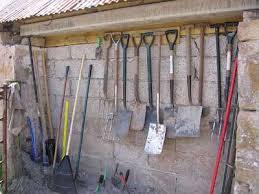Dear Family & Friends
My husband have a few garden tools stored in the barn.... the shovel, the fork, the pick ax etc...and I notice it is expanding by the year too!
Every morning when I head to work (in the garden, of course!)...I just carry with me 3 things: my fashionable handbag, I mean a bucket...and inside - a hand trowel, an old pencil colour, and a scissor. Life is just that simple!
Every morning when I head to work (in the garden, of course!)...I just carry with me 3 things: my fashionable handbag, I mean a bucket...and inside - a hand trowel, an old pencil colour, and a scissor. Life is just that simple!
The bucket handbag can hold the pulled weeds to take to the compost bin...or to hold some collection of harvest to take back to the kitchen for the day's use. That's actually what I call my 'pay' but I don't need a wallet for that, nor a lips-stick in my handbag for the matter ;P
My girl's old pencil colour is a good recycled tool for poking holes and lifting seedlings out of pots. The hand trowel is useful for digging bigger holes for planting, so finger nails don't get damaged, and for picking bugs you don't like to touch etc...
The scissors is also handy for opening new seed packets, specially the foiled secured packets where no nails or teeth can tear, and for harvesting veggies and flowers...or just snipping old death plants to tidy up a bit. When feeling cruel, to snip slugs before they escape! (now that's gross!...better to just let the chickens do the job ;) so, use the hand trowel...scoop it and toss in the air... be sure to have it land inside the chicken pen!
The scissors is also handy for opening new seed packets, specially the foiled secured packets where no nails or teeth can tear, and for harvesting veggies and flowers...or just snipping old death plants to tidy up a bit. When feeling cruel, to snip slugs before they escape! (now that's gross!...better to just let the chickens do the job ;) so, use the hand trowel...scoop it and toss in the air... be sure to have it land inside the chicken pen!
What tools do you carry to work each day? Any powerful weapons for a powerful job?
Happy gardening day!
Yours





